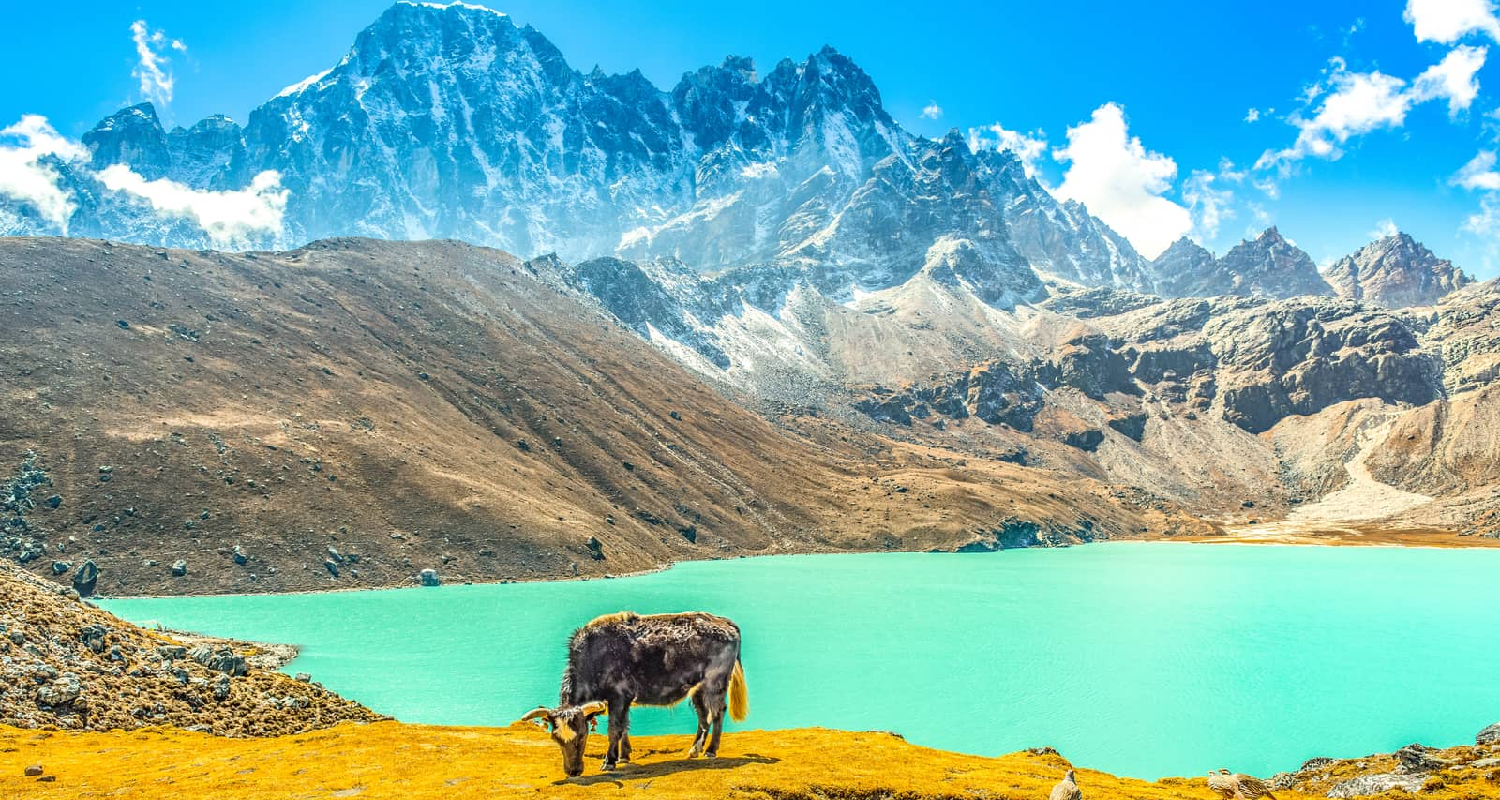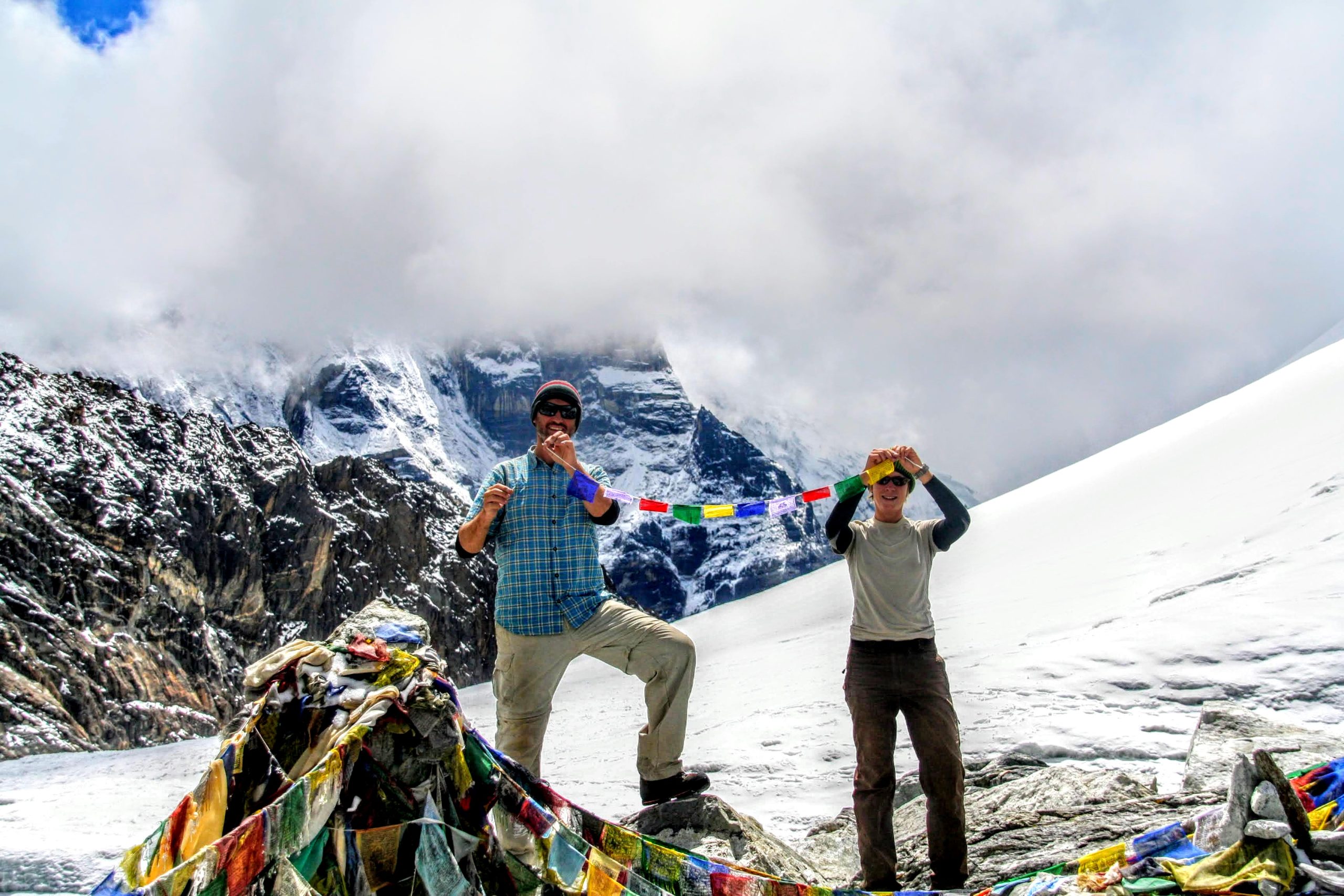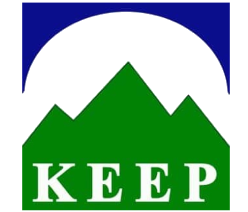Good to Know
- LOCATION
- Everest Region
- DURATION
- 14 Days
- Difficulty Level
- Moderate
- ARRIVAL ON
- Kathmandu Nepal
- DEPARTURE FROM
- Kathmandu Nepal
- TRIP TYPE
- treking
- MAX ALTITUDE
- 5483 meters
- GROUP SIZE
- 12
- MEAL
- Breakfast - Lunch - Dinner
- ACCOMMODATION
- Guest House/ Hotels
- TRANSPORTATION
- By air
- TRIP CODE
- HHTE GVT
Gokyo Valley Trek
Trekking Overview and Trip Information
The Gokyo Valley Trek is a mesmerizing journey that takes you deep into the heart of the Everest region of Nepal. Known for its breathtaking landscapes, pristine glacial lakes, and stunning mountain vistas, this trek offers an unforgettable experience for travelers seeking adventure and natural beauty. Here’s an overview and essential trip information for travelers coming to Nepal from foreign countries.
Welcome to the Gokyo Valley Trek, a journey that takes you deep into the heart of the Everest region, offering an exceptional and less-crowded alternative to the traditional Everest Base Camp trek. Situated in the breathtaking landscapes of the Khumbu region, the Gokyo Valley trek promises unparalleled natural beauty, serene glacial lakes, and intimate encounters with Sherpa culture. Gokyo Valley Trekking is second famous Trekking in Everest region or alternative trek to the traditional Everest Base Camp Trek that offers magnificent view of the mountain peaks and the Ngozumpa Glacier- the largest in the Nepal Himalayas.The image of of this region is associated with the soaring view of the most popular mountains in Nepal, at an altitude of 8000m including Cho Oyu, Everest, Lhotse and Makalu which are clearly visible from Gokyo Ri (5483m.) above Gokyo Lake.It is one of the most remarkable feature of the trek is the view of tremendous ice ridge between Cho Oyu and Gyachung (2922m) located in Khumbu region.This extraordinary trek is also worthy in a sense that it offers an ample opportunity to explore the amazing destination and its impressive sight, which is beyond human imagination. After a thirty five minute flight from Kathmandu landing at Lukla’s tiny airstrip, the Adventure really begins. We spend the next few days Trekking and interacting amongst the mountain people also known as Sherpa’s we stay at local lodges and trek into the heartland of their villages. Everything is organized in conjunction with local Sherpa guides. Along the trek we will pass Buddhist monasteries with the views of Everest and other snow towering mountains getting closer by the day. We will have rest days in the villages of Namche bazaar that will allow us to explore the region and to acclimatize, which is very important. After Trekking to Gokyo Ri (5483m), we return at a leisurely pace back to Namche and Lukla for our flight back to Kathmandu.
Geographical knowledge of the land you will tread:
The Gokyo Valley Trek takes you through the stunning landscapes of the Everest region, providing a unique geographical experience. Here’s some geographical knowledge about the land you will tread during the Gokyo Valley Trek:
- 1. Location: The Gokyo Valley is situated in the Solukhumbu District of the Sagarmatha Zone in northeastern Nepal. It lies within the Sagarmatha National Park, a UNESCO World Heritage Site, and is part of the larger Khumbu region.
- 2. Altitude: The trek encompasses a wide range of elevations. It starts in Lukla at approximately 2,800 meters (9,186 feet) and gradually ascends to the highest point at Gokyo Ri, which is at an elevation of 5,357 meters (17,575 feet). The varying altitudes present diverse ecosystems and climates.
- 3. Gokyo Lakes: The Gokyo Valley is famous for its stunning series of glacial lakes known as the Gokyo Lakes. There are six main lakes, the largest being the Third Lake (Dudh Pokhari). These pristine turquoise lakes are situated at elevations ranging from approximately 4,700 meters (15,420 feet) to 5,000 meters (16,404 feet).
- 4. Ngozumpa Glacier: While trekking towards Gokyo, you’ll pass alongside the Ngozumpa Glacier, which is the largest glacier in the Himalayas. The glacier stretches for approximately 36 kilometers (22 miles) and is a prominent geographical feature of the region.
- 5. Mountain Views: The trek offers spectacular views of some of the world’s highest peaks, including Mount Everest (8,848 meters/29,029 feet), Lhotse (8,516 meters/27,940 feet), Makalu (8,485 meters/27,838 feet), and Cho Oyu (8,188 meters/26,864 feet). The vantage point of Gokyo Ri provides breathtaking panoramic vistas of these giants.
- 6. Valleys and Passes: The trek involves crossing high mountain passes like Renjo La Pass (5,340 meters/17,520 feet) and Cho La Pass (5,420 meters/17,782 feet). These passes offer incredible views and are integral to the trekking route.
- 7. Rivers and Streams: You’ll encounter various rivers and streams throughout the trek, many of which originate from the melting glaciers in the region. These waterways contribute to the lush vegetation and offer refreshing water sources.
- 8. Vegetation Zones: As you ascend in altitude, you’ll pass through different vegetation zones, including lush forests of rhododendron, pine, and juniper in the lower elevations. As you go higher, the landscape transitions to alpine meadows and eventually barren and rocky terrain.
- 9. Cultural Villages: Along the trek, you’ll pass through traditional Sherpa villages like Namche Bazaar, Dole, and Machhermo. These settlements offer insights into the unique culture and lifestyle of the local Sherpa people.
- 10. Sagarmatha National Park: The entire Gokyo Valley Trek falls within the boundaries of Sagarmatha National Park, which was established to protect the unique biodiversity and natural beauty of the region. It’s home to a variety of wildlife, including the elusive snow leopard.
Understanding the geographical features and variations along the Gokyo Valley Trek enhances your appreciation of this stunning region. From glacial lakes to towering peaks, the landscapes are diverse and awe-inspiring, making it a must-visit destination for trekkers and nature enthusiasts.
Trail Overview and Cultural Experience Along the Gokyo Valley Trek:
The Gokyo Valley Trek is one of the most picturesque and culturally rich treks in the Khumbu region of Nepal, which is famous for its stunning mountain landscapes, including views of some of the world’s highest peaks, as well as its unique Sherpa culture. Here’s an overview of the trek and the cultural experiences you can expect along the way:
- – Location: The Gokyo Valley Trek is located in the Solu Khumbu region of Nepal, in the Sagarmatha National Park. It starts and ends in Lukla, which is accessible by a short flight from Kathmandu.
- – Duration: The trek typically takes around 12 to 16 days, depending on your itinerary and pace.
- – Altitude: The highest point of the trek is the Gokyo Ri viewpoint, which stands at 5,357 meters (17,575 feet) above sea level. Trekkers should be prepared for high-altitude conditions and acclimatization stops along the way.
Cultural Experiences:
- 1. Sherpa Culture: The Gokyo Valley is inhabited by Sherpa people, known for their warm hospitality and rich cultural traditions. Along the trek, you’ll have the opportunity to visit Sherpa villages, interact with the locals, and learn about their way of life.
- 2. Monasteries and Gompas: You’ll come across several Buddhist monasteries and gompas (temples) during the trek. One of the most famous is the Tengboche Monastery, which offers beautiful views of Ama Dablam and is an important spiritual center for Sherpas.
- 3. Prayer Flags and Mani Walls: The trekking trails are often adorned with colorful prayer flags and mani walls (stone walls inscribed with Buddhist prayers and symbols). You can participate in the local tradition of spinning prayer wheels and making offerings.
- 4. Local Cuisine: Enjoy traditional Sherpa cuisine along the trek. Try dishes like momo (dumplings), thukpa (noodle soup), and yak-based products like yak cheese and yak butter tea.
- 5. Sherpa Festivals: Depending on the timing of your trek, you might have the chance to witness Sherpa festivals. The Mani Rimdu festival, held at Tengboche Monastery in October or November, is a major event that showcases traditional dances and rituals.
- 6. Tea Houses and Lodges: You’ll stay in teahouses and lodges along the trail, which provides an opportunity to interact with the local hosts and fellow trekkers. It’s a great way to exchange stories and experiences.
The Gokyo Valley Trek offers a perfect blend of natural beauty and cultural immersion. It’s an unforgettable journey for trekkers looking to explore the Himalayas while experiencing the unique culture of the Sherpa people. Remember to plan your trek carefully, including acclimatization stops, to ensure a safe and enjoyable experience in this high-altitude environment.
Facilities and accommodation along the Gokyo Valley Trek
Accommodation and facilities along the Gokyo Valley Trek have improved over the years due to its popularity as a trekking destination. While the facilities are more basic compared to urban areas, you can still find comfortable places to stay and essential amenities. Here’s what you can expect in terms of accommodation and facilities along the trek:
- 1. Teahouses and Lodges:
– The primary accommodation option on the Gokyo Valley Trek is teahouses or lodges. These are simple, family-run guesthouses that offer basic rooms with beds, blankets, and sometimes heating stoves.
– Rooms may have shared bathrooms, and the quality of facilities can vary from one teahouse to another.
– In popular trekking villages like Namche Bazaar and Gokyo, you’ll find a range of teahouses with varying levels of comfort and services. - 2. Food and Dining:
– Teahouses and lodges along the trek serve a variety of meals, including traditional Nepali, Tibetan, and international dishes.
– Expect basic but hearty meals like dal bhat (rice and lentil soup), momo (dumplings), noodles, and various soups.
– In higher-altitude villages, the menu options may be more limited due to the remote location. - 3. Drinking Water:
– You can purchase bottled water at teahouses, but it can be expensive and environmentally unfriendly. It’s advisable to carry a reusable water bottle and use water purification methods or purchase boiled water to refill it. - 4. Electricity and Charging:
– Most teahouses have electricity, but it is generated by solar panels or small hydroelectric systems, so it may be limited.
– Charging electronic devices like cameras and phones is usually possible for a fee. - 5. Wi-Fi and Internet:
– Some teahouses offer Wi-Fi for a fee, but the quality and speed can vary widely, and there may be limited connectivity in higher-altitude areas. - 6. Hot Showers:
– Hot showers are available at some teahouses, but they may come with an additional charge.
– In higher-altitude areas, hot water may be limited, and you might have to settle for a bucket shower or a bowl of hot water. - 7. Toilets:
– Teahouses typically have squat toilets, and toilet paper may not always be provided. Carry your own toilet paper and hand sanitizer. - 8. Medical Facilities:
– Basic medical facilities and pharmacies are available in larger villages like Namche Bazaar, but you should carry a basic medical kit with essentials like pain relievers, altitude sickness medication, and first-aid supplies. - 9. ATM and Money Exchange:
– Namche Bazaar has ATMs, and you can exchange foreign currency there. However, it’s advisable to carry enough cash in Nepali Rupees for your entire trek as ATM availability can be unreliable in more remote areas. - 10. Accommodation Booking:
– During the peak trekking seasons (spring and autumn), it’s a good idea to book your accommodation in advance in popular villages. This ensures you have a place to stay, especially in high-demand teahouses.
Keep in mind that the availability and quality of facilities may change, so it’s essential to be flexible and prepared for varying conditions along the Gokyo Valley Trek. It’s also advisable to carry some essential trekking gear, including warm clothing, a good sleeping bag, and a trekking map or guidebook to navigate the trail and make your trek comfortable and enjoyable.
Can Beginners Trek to Gokyo Valley Trek?
Trekking to the Gokyo Valley is a challenging adventure that involves hiking at high altitudes in the Himalayas. While it’s not impossible for beginners to attempt the Gokyo Valley Trek, it is essential to understand that it can be physically demanding and requires proper preparation and acclimatization. Here are some considerations for beginners:
- 1. Physical Fitness:
– The Gokyo Valley Trek involves long days of hiking, often on steep and uneven terrain. Prior physical fitness is essential to tackle the challenges of the trek.
– It’s advisable to engage in regular cardiovascular and strength training exercises to build endurance and stamina before embarking on the trek. - 2. Altitude Acclimatization:
– Altitude sickness is a real concern when trekking in the Himalayas. The Gokyo Valley Trek takes you to high altitudes, and it’s crucial to acclimatize properly to minimize the risk of altitude-related illnesses.
– Beginners should plan an itinerary that includes adequate acclimatization days and gradual altitude gain. This allows your body to adjust to the reduced oxygen levels at high altitudes. - 3. Trekking Experience:
– While prior trekking experience is not mandatory, it can be helpful for beginners. If you are new to trekking, consider starting with shorter and less challenging treks to gain experience and confidence. - 4. Guided vs. Independent Trek:
– Beginners may benefit from hiring a local guide and/or porter. A guide can provide valuable assistance, navigate the trail, and offer insights into the local culture.
– A porter can carry your heavy backpack, allowing you to trek with a lighter load, which can be especially helpful at higher altitudes. - 5. Gear and Preparation:
– Proper trekking gear is essential, including warm clothing, a good quality sleeping bag, hiking boots, and a rain jacket. Make sure your gear is appropriate for the conditions you’ll encounter.
– Adequate trekking preparation, including researching the trail, weather conditions, and packing essentials, is crucial for a successful trek. - 6. Trekking Permits:
– Ensure that you obtain the necessary trekking permits and follow local regulations. Permits can be arranged in Kathmandu or at entry points to the Sagarmatha National Park. - 7. Season and Weather:
– The best times for the Gokyo Valley Trek are the spring (March to May) and autumn (September to November) when the weather is generally more stable and the trails are at their best. - 8. Be Prepared for Changes:
– Weather conditions can change rapidly in the Himalayas, so be prepared for unexpected weather events and have a contingency plan.
Alternative Treks You Can Consider in Gokyo Valley Trek
While the Gokyo Valley Trek is a popular and stunning trekking route in the Khumbu region of Nepal, there are several alternative treks and side trips you can consider in the same area to explore the region more comprehensively or to add variety to your trekking experience. Here are some alternative treks and side trips you can consider while in the Gokyo Valley region:
- 1. Everest Base Camp Trek:
– The Everest Base Camp Trek is one of the most iconic treks in the world and can be combined with the Gokyo Valley Trek. You can trek to Gokyo first and then cross the Cho La Pass to join the Everest Base Camp route. This extended trek offers breathtaking views and a more comprehensive Everest experience. - 2. Renjo La Pass Trek:
– The Renjo La Pass Trek is a side trip from Gokyo that takes you over the Renjo La Pass (5,360 meters) and offers panoramic views of Everest, Lhotse, Makalu, and Cho Oyu. This trek provides an alternative route to reach Thame and Namche Bazaar. - 3. Thame Valley Trek:
– The Thame Valley Trek is a less-traveled route that starts from Namche Bazaar and takes you to the picturesque Thame village. It offers a chance to explore Sherpa culture and visit the Thame Monastery. - 4. Kongma La Pass Trek:
– The Kongma La Pass Trek is another side trip option for those looking to extend their trekking adventure. This trek crosses the Kongma La Pass (5,535 meters) and connects the Gokyo Valley with the Everest Base Camp trail. - 5. Three Passes Trek:
– The Three Passes Trek is an extended trek that combines the Gokyo Valley, Renjo La Pass, Cho La Pass, and Kongma La Pass to form a challenging circuit trek. It’s suitable for experienced trekkers seeking a comprehensive and physically demanding adventure. - 6. Tengboche Monastery Trek:
– This short trek focuses on visiting the famous Tengboche Monastery and offers excellent views of Ama Dablam. It’s a great option for those with limited time or looking for a less strenuous trek. - 7. Helicopter Tours:
– If trekking is not your preference or if you have limited time, you can consider taking a helicopter tour from Kathmandu to the Everest region. This allows you to enjoy breathtaking aerial views of the Himalayas and land at key locations like Everest Base Camp or Gokyo. - 8. Side Trips to Additional Gokyo Lakes:
– In addition to the main Gokyo Lakes, there are several smaller, less-visited lakes in the area. You can explore these lakes as side trips for a quieter and more secluded experience.
When considering these alternative treks and side trips, it’s essential to plan your itinerary, acclimatization, and permits accordingly. Some of these routes are more challenging and require proper preparation and a higher level of fitness. Consulting with local trekking agencies and guides can help you customize your trek based on your preferences, fitness level, and the time you have available.
Trip Duration:
The Gokyo Valley Trek typically spans 12 to 14 days, depending on the specific itinerary, acclimatization needs, and side trips.
Permits:
To embark on the Gokyo Valley Trek, foreign travelers need to obtain two main permits:
- 1. Sagarmatha National Park Entry Permit: Required for entry into the Sagarmatha National Park, which encompasses the Everest region.
- 2. Local Area Permit (Gokyo-Ri/Khumbu VDC): This permit covers entry into the Gokyo Valley and other destinations within the Khumbu region.
Best Time to Trek:
The best seasons for the Gokyo Valley Trek are spring (March to May) and autumn (September to November). These months offer stable weather, clear skies, and excellent visibility, making it an ideal time for trekking.
Trek Difficulty:
The Gokyo Valley Trek is considered moderately challenging due to its altitude and variable weather conditions. Adequate physical fitness and proper acclimatization are essential for a successful and safe trek.
Accommodation:
Along the trek, you’ll stay in teahouses and lodges. These offer basic yet comfortable accommodations with warm meals and cozy common areas. While facilities are simple, they provide a genuine Himalayan experience.
Safety Considerations:
Altitude sickness is a risk on this trek. Proper acclimatization, hydration, and trekking at a gradual pace are crucial for your safety. It’s recommended to trek with a reputable guide who can monitor your health and ensure a safe journey.
The Gokyo Valley Trek offers a remarkable blend of natural beauty, cultural encounters, and high-altitude adventure. It’s a perfect choice for foreign travelers seeking an alternative to the more crowded Everest Base Camp route while still experiencing the grandeur of the Everest region. With the right permits, equipment, and preparation, the Gokyo Valley Trek promises an unforgettable trekking experience in the heart of the Himalayas.
Highlights
- 1. Gokyo Lakes: The trek’s centrepiece, the Gokyo Lakes, consists of a series of turquoise glacial lakes surrounded by towering peaks. Gokyo’s serene and pristine beauty is a sight to behold, offering unparalleled photo opportunities.
- 2. Gokyo Ri: Climbing to the summit of Gokyo Ri (5,360 meters) provides one of the most awe-inspiring panoramic views in the Himalayas. From this vantage point, you’ll witness the majesty of Mount Everest, Lhotse, Makalu, Cho Oyu, and a host of other peaks.
- 3. Sherpa Culture: As you trek through charming villages like Namche Bazaar, Dole, and Machhermo, you’ll have the chance to immerse yourself in the rich Sherpa culture. Visit monasteries, interact with friendly locals, and learn about their traditional way of life.
- 4. Gokyo Village: Gokyo Village, nestled by the Gokyo Lakes, is a cultural gem. It offers unique opportunities for cultural exchanges, where you can interact with locals and perhaps even join in traditional Sherpa dances or songs.
- 5. Tengboche Monastery: On the way to Gokyo, you can visit Tengboche Monastery, a sacred Buddhist site perched on a ridge. Witness morning prayers, colorful festivals, and learn about Tibetan Buddhism from resident monks.
- 6. Three Passes: The Gokyo Valley trek can be combined with the Three Passes Trek, which crosses three high passes (Kongma La, Cho La, and Renjo La). This adds an adventurous element to the trek, allowing you to explore even more of the region.
- 7. Breathtaking Landscapes: The trek offers diverse landscapes, from lush forests and rhododendron-filled trails to high-altitude desert terrain. The ever-changing scenery keeps the trek exciting and visually captivating.
- 8. Practical Difficulty: The Gokyo Valley trek presents challenges due to its high-altitude terrain, making it an adventure for trekkers seeking a rewarding and somewhat challenging experience without the crowds of the Everest Base Camp route.
- 9. Rich Wildlife: Keep an eye out for wildlife along the way, including Himalayan tahrs, snow leopards, and various species of birds. The Sagarmatha National Park is home to diverse fauna and flora.
- 10. Friendly Teahouse Culture: Experience the warm hospitality of teahouse owners and fellow trekkers. Teahouses provide a cozy place to rest, enjoy hearty meals, and share stories with fellow adventurers.
Itinerary
Following your arrival at TIA, You’ll be welcomed to Nepal by a representative of Hiking Himalayas at TIA’s arrival terminal. We’ll transfer you to the hotel in a tourist van [Duration: 30 mins].
Overnight Stay in Kathmandu.
An early morning start takes us to Tribhuwan International Airport in Kathmandu for the 35-minute scenic flight to Lukla(2850m). On arrival at the Tenzing-Hillary airport, the guide will brief you and introduce our porters before we begin our trek towards Phakding(2650m).
Overnight Stay in Phakding.
After breakfast, we hit the trail and head towards Namche Bazaar. We’ll cross the river on high-suspension bridges several times over the Dudh Koshi River. We’ll enter Sagarmatha National Park after crossing Monjo(2845m). We’ll ascend aggressively with the trail to Namche(3450m) enjoying some breathtaking views. If the weather is clear, we get the first glimpse of Mt Everest. Namche is the main trading village in the Khumbu and has a busy Saturday market – a meeting place for the Hindu traders from the lowlands and the Tibetan yak caravans that have crossed the glaciated Nangpa La.
Namche Bazaar is known as the Gateway to Everest, here, you’ll find many good hotels and lodges. Along the whole Everest trail, this is quite a big village.
Overnight Stay in Namche
Today, we’ll spend a day here to acclimatize and adjust to the thinning of the air. We’ll go for a short trek to a museum celebrating the traditional customs of the Sherpa people. We’ll hike up the Syangboche Airport, and around Everest View Hotel. From this point, we have rewarding views of the Himalayas with a stunning sunrise or sunset over the panorama of the Khumbu peaks.
Overnight stay in Namche Bazaar.
Today, the trail descends to the Dudh Koshi River and then climbs steeply out of Valley through a rhododendron forest, juniper. After a while large conifers start to appear as the elevation increases making trekking beautiful in spring. The trail passes through Yak Kharkas and summer settlements before reaching Phortse Thanga. The views of Khumbi La and Tawache are magnificent throughout the day.
Overnight stay in Phortse Thanga.
The trail climbs a ridge for an excellent view both down the valley to Kengtega and up towards Cho Oyu and descends to a river and climbs steeply to the terminal moraine of the Ngozumpz glacier. We’ll pass by the villages of Dole(4038m)and Luza(4375m) before reaching Machhermo(4470m), a picturesque village with breathtaking mountain views.
Overnight stay in Machhermo.
On the 7th day of our trip, we’ll finally reach the beautiful Gokyo Valley. You’ll climb steeply up a ridge and enjoy stunning views of the Dudh Koshi Valley and Cho Oyu, the sixth-highest mountain in the world. The trail then descends to the first of the Gokyo Lakes, Longpongo(4690m), and continues to the second lake, Taboche Tsho. Finally, you’ll reach the third lake, Gokyo Lake, where you’ll spend the night.
Today, early in the morning we have steep climb up to the top of Gokyo Ri(5483m), ample rewards to anyone that attempts this trip. Here are stunning views of the supper Gokyo Valley, the massive Ngozumpa Glacier and an incredible panoramic view of the whole Khumbu Himalayas, such as Everest, Lhotse, Nuptse, Makalu, Cho–Oyu and Gychung Kang can be seen. Those who explore the glacier and Gokyo Peak are rewarded.
Overnight stay in Gokyo.
Today, we’ll Leave Gokyo, and retrace our steps back towards Namche Bazaar. The trail descends through forests and passes by small settlements, including Machhermo and Luza. We’ll eventually reach Dole, here, we’ll spend our night.
Overnight Stay in Dole.
After breakfast, we’ll descend to Namche Bazaar via typical Sherpa village of Khumjung . Leaving the mountains behind us, our descent continues back to the town of Namche Bazaar(3441m).
Overnight stay in Namche Bazaar.
Finally we’ll return to Lukla where the trek began, which seems a lifetime ago. Enjoying time to reflect on the trek as a group and the personal achievement of all those who took part.
Overnight stay in Lukla(2860m).
An early morning 35 minute scenic flight back to Kathmandu provides time to reflect upon the mountains you have recently visited for one last time.
Overnight stay in Kathmandu.
Kathmandu is the historical and cultural heart of Nepal and has been a popular destination for tourists ever since Nepal opened its doors to visitors. The city presents a wonderful mix of Hinduism, Tibetan Buddhism, and Western influence in the Valley. Patan and Bhaktapur, their two major neighboring cities bear immense historical, cultural, and religious significance. There will be a half-day guided tour to the famous and biggest Hindu shrine of Pashupatinath, Boudhanath – the largest Buddhist stupa in Nepal, Bhaktapur Durbar Square – the 15th-century palace of 55 windows, and Swoyambhunath. At the event, you will be briefed about your trip.
After we finish Sightseeing, You’ll be gifted with an evening farewell dinner in a traditional way and many other surprises, for they’ve had a quality time with you.
Overnight Stay in Kathmandu.
Our Nepalese support team will take you to the airport for your flight home. (Or stay longer for short tours such as drive at National parks, do some wild-water rafting, a Tibet tour, or even mountain biking, etc – please don’t hesitate to let us know). We would be glad to help you. Thank you for doing this venture with us & it’s been wonderful knowing you over the weeks. Please do stay in touch in the months ahead. Bon Voyage & take care!!!
Or,
Extend Your Stay in NEPAL
Not satisfied with this regular itinerary? Make your own.
Inclusions
Service Includes:
- Pick-up and drop-off services between Tribhuvan International Airport in Kathmandu and your accommodation.
- Twin-sharing 4 night accommodation in Kathmandu after and before trip on B/B basis
- A full day sightseeing tour in Kathmandu valley (Pashupatinath Temple, Boudhanath, Shwayambhu, and Kathmandu durbar square)
- 10 night accommodation in lodge/tea house during trekking
- Round way flights(Kathmnadu/Manthali/Lukla) and airport departure taxes
- 3 meals a day (Breakfast/Lunch/Dinner) & seasonable fruits during the Trek
- An experienced English-speaking ,Trained, educated ,professional and friendly Guide including to his food, accommodation, salary, insurance,flight ticket and airport tax
- Essential porters their food, accommodation, salary, insurance & equipment
- All necessary paper work and permits (Sagarmatha National park permit, Local Permit & TIMS )
- A comprehensive medical kit
- Hiking Himalayas Waterproof Duffel bag and trip completion certificate
- Portable Altitudes Chamber (PAC) for safety measures
- All applicable local tax, vat and office service charge
- Farewell dinner (Nepali Traditional meal) last night
Service Excludes:
- Nepal visa fee
- International Airfare to and from Kathmandu
- Food (Lunch & Dinner) before and after the trek in Kathmandu
- Personal expenses (phone calls, laundry, bar bills, battery recharge, extra porters, bottle or boiled water, Hot and cold drinks,WiFi, shower etc)
- Personal Travel insurance and rescue operation in case of emergency.
- Additional costs- extra days stay, incase of flight cancellation due to the natural calamities, bad weather forecast and other unforeseen circumstances
- Tips for guide and porters
Gallery & Video
Trekking Equipment
When preparing for the Gokyo Valley trek, it’s crucial to have the right trekking equipment to ensure your safety and comfort in the high-altitude environment. Here’s a list of essential trekking equipment for the Gokyo Trekking:
Clothing:
- 1. Moisture-Wicking Base Layers: Lightweight and breathable shirts and pants to regulate body temperature and wick away sweat.
- 2. Insulating Layers: Fleece jackets or down jackets to keep warm in colder temperatures.
- 3. Waterproof and Windproof Jacket: A durable and breathable outer shell to protect against rain, snow, and wind.
- 4. Trekking Pants: Lightweight, quick-drying, and comfortable pants for trekking.
- 5. Trekking Shorts: Optional for lower altitudes and warmer days.
- 6. Headwear: A warm hat, sun hat, sunglasses with UV protection, and a buff or neck gaiter to protect against the sun and cold.
- 7. Gloves: Insulated, waterproof gloves and liner gloves for added warmth and dexterity.
Footwear:
- 8. Trekking Boots: Sturdy and waterproof hiking boots with ankle support for rough terrain.
- 9. Hiking Socks: Moisture-wicking and warm socks with extra pairs for changing.
- 10. Gaiters: Optional but helpful for keeping snow and debris out of your boots.
Backpack and Accessories:
- 11. Backpack: A comfortable daypack or larger backpack for carrying your essentials.
- 12. Sleeping Bag: A high-quality sleeping bag rated for cold temperatures (0°F or -15°C) for higher altitudes.
- 13. Trekking Poles: Optional but beneficial for stability and reducing strain on your knees during descents.
- 14. Water Bottle or Hydration System: A reusable water bottle or hydration bladder to stay hydrated along the trail.
- 15. Headlamp: With extra batteries for early morning or late-night hikes.
- 16. Duffel Bag or Dry Bag: To store extra gear that you won’t need during the day while porters carry it.
Personal Items and Toiletries:
- 17. Sunscreen: High SPF sunscreen to protect against strong mountain sun.
- 18. Lip Balm: With sunblock to prevent chapped lips.
- 19. Toiletries: Including a small towel, biodegradable soap, toothbrush, toothpaste, and personal hygiene items.
- 20. First Aid Kit: Including basic medications for altitude sickness, pain relief, and any personal prescriptions.
Climbing Gear (if crossing high passes):
- 21. Crampons: For traction on icy trails if crossing high passes in colder months.
- 22. Ice Axe: To assist with balance and stability on steep and icy terrain.
- Miscellaneous:
- 23. Trekking Maps and Guidebook: For navigation and reference.
- 24. Cash: In Nepali rupees for purchasing items along the trek (ATMs are limited).
- 25. Photographic Equipment: Camera, extra batteries, and memory cards.
- 26. Travel Insurance: With coverage for high-altitude trekking and emergency evacuation.
This equipment list is a general guideline. Depending on the season and your preferences, you may need to adjust your gear accordingly. Be sure to check the specific requirements with your trekking agency and guide before embarking on the Gokyo Valley trek.
FAQ's
With more than 20+ years of experience in the tourism industry, our organization focuses on customer satisfaction and quality services. Our team comprises experienced and licensed tourist guides and moreover, Our agency is a registered travel agency under the Ministry of Tourism. It is also a license holder of NMA, NTB, and NRB. Moreover, we provide our clients with local guide to make you acknowledge about the place more deeply.
Yes, Internet facilities are available in this Trail. You'll get Wifi card available on the trail. With this card, you'll be able to use wifi in the Everest region for certain days. This wifi card will cost you according to the package you choose.
The new law of Nepal makes it compulsory for international traveller's to have a guide while trekking in the mountainous regions of Nepal. So, it is mandatory to have a guide even if you're a solo traveller.
Our team is comprised of experienced and licensed guides who are also good at medical assistance. So, you can trust the guides of our agency.
Based on your satisfaction and the guides' behavior you can tip the guides. We suggest you tip up to 15% of the total trip cost to the guides.
Gokyo Valley Trek is considered moderately challenging. You'll have to walk for longer distances and up to 5-6 hours per day to complete this trek.
This Itinerary is made while keeping acclimatization as a key factor. We wont take you directly to high altitudes without acclimatizing. So, there is less chances for you to get altitude sickness.
The Gokyo Valley trek is a trekking adventure in the Everest region of Nepal. It takes you through the stunning Gokyo Valley, known for its pristine glacial lakes, and offers panoramic views of the Everest massif.
The trek typically takes around 10 to 14 days, depending on your itinerary and pace. This duration allows for acclimatization and exploration of the area.
The best times for the trek are during the spring (March to May) and fall (September to November) when the weather is stable, skies are clear, and the landscapes are at their most beautiful.
While it's possible to trek independently, hiring an experienced guide is recommended for navigation, cultural insights, and safety. Porters can also be hired to carry your main backpack, making the trek more comfortable.
The trek is considered moderate in terms of difficulty. While it doesn't involve technical climbing, the high altitude can be challenging. Adequate acclimatization is crucial.
Pack essentials like warm clothing, a good-quality sleeping bag, sturdy hiking boots, layers of clothing, a rain jacket, a backpack, a water purification system, and personal hygiene items.
ATM facilities are limited in the region. It's advisable to carry enough Nepali rupees in cash to cover your expenses during the trek.


















